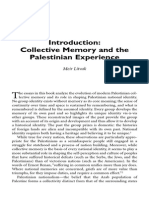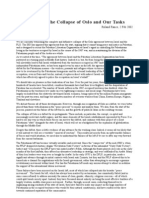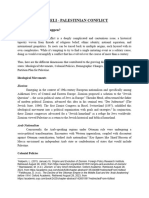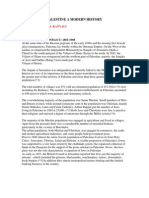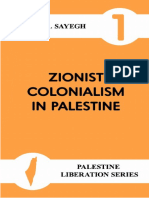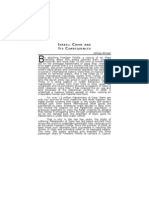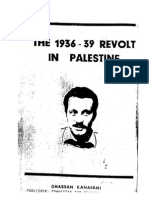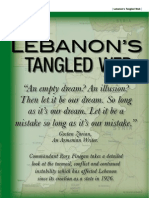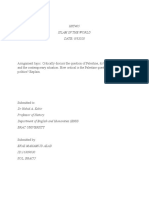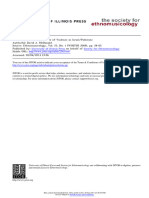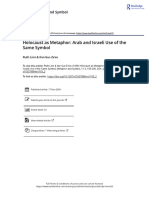Pro Muus
Pro Muus
Uploaded by
larryfoleCopyright:
Available Formats
Pro Muus
Pro Muus
Uploaded by
larryfoleOriginal Title
Copyright
Available Formats
Share this document
Did you find this document useful?
Is this content inappropriate?
Copyright:
Available Formats
Pro Muus
Pro Muus
Uploaded by
larryfoleCopyright:
Available Formats
Access provided by University Sains Malaysia (3 Apr 2013 03:20 GMT)
::
Asad Ghanem
Palestinian Nationalism: An Overview
INTRODUCTION
Accoiiixc ro rui iiriiaruii ruiii aii rwo r\iis oi xarioxai-
ism: First, Civic (territorial) nationalism emphasizes the common territory
and citizenship as the criteria for individuals inclusion in the national
group. Here the national group is the totality of citizens, with no emphasis
on their primordial ethnic aliation; the national culture consists chiey
of civic and universal values. Tis kind of nationalism is found in France,
Great Britain, and the United States. Civic nationalism crystallizes under
the shadow of attempts to establish hegemony for the dominant group
culture, values and basic beliefs.
Second, ethnic nationalism lays the major emphasis on primordial
ethnic aliation as the criterion for inclusion within the national group.
Te values shared by the members of the national group are chiey the
groups historical heritage and primordial ethnic values. Tis type of nation-
alism can be found everywherein the Tird World, the Middle East,
Eastern Europe, and Africa. Tis kind of nationalism is crystallized mainly
as a reection of the meeting or clash with the other.
PALESTINIAN NATIONALISM
Until the establishment of the Palestinian National Authority (PNA) after
the signing of the Declaration of Principles and Interim Agreement in :,,,,
the Palestinians demand for the establishment of an independent state
went through several major stages. What follows is a general survey of the
stages in the development of the Palestinian national movement from its
beginnings through the establishment of the PNA.
:: isiaii sruiiis, voiuxi : xuxnii :
THE PALESTINIANS AWAKEN TO A CRUSHING DEFEAT
Te rst steps in the development of the Palestinian national movement
were taken in the early twentieth century and were strongly inuenced
by the Zionist movement and the Jews aspirations to establish a state.
Tey emerged from the Emir Feisals abortive attempt to establish a state
of Greater Syria and the subsequent institution of the British mandate
over Palestine, as provided for by the Sykes-Picot agreement that allocated
Syria and Lebanon to France and Southern Syria ( Jordan and Palestine)
to Great Britain.
Tis political separation helped reinforce Palestinian national con-
sciousness at the expense of Pan-Syrianism. During the :,:cs and :,,cs,
real attempts were made to establish national institutions and develop
organizational structures for the movement. Special eorts were invested in
founding Muslim-Christian societies in the larger cities and, later, national-
ist societies that were considered to be more advanced forms of organi-
zation than the confessional societies. Various bodies were established to
represent all or most of the Palestinian population. Te rst of these was
the Palestinian Arab Executive Committee, in :,:c, soon followed by the
Palestinian Higher Committee, headed by Haj Amin al-Husseini. Tese
organizations made a serious contribution towards crystallizing the early
ideological lines of the Palestinian national movement and its arguments for
the existence of a Palestinian people with a right to a Palestinian homeland.
Violent disturbances against the Jews and the Zionist movement, as well as
against the Mandate, broke out in :,:,.
Te rst serious steps were taken towards the formation of Palestinian
political parties. Tese parties, with the exception of the Independence
Party (Hizb al-Istiqlal), reected the clan structure of contemporary Pales-
tinian society: the Husseini family and its allies versus the Nashashibi family
and its supporters. During the :,,cs, because of events in Europe and the
rise of the Nazi Party in Germany, there was massive Jewish immigration to
mandatory Palestine; the pressures created by this immigration and by the
British mandatory government led to the outbreak of the :,,o,, revolt,
which included extended strikes and demonstrations. Tese events were a
further step towards the appearance of the Palestinian national movement.
From the Palestinian point of view the results of these events were dis-
appointing, especially after the massive intervention by Arab leaders from
neighboring countries to end the strikes and disturbances. Tis interven-
tion, which widened in subsequent years, marked the beginning of the Ara-
bization of the Palestinian problem, which subsequently had a signicant
Palestinian Nationalism: An Overview :,
impact on the course of the Palestinian problem and the evolution of
political activity among the Palestinians.
Te disappointing results of the Arab Revolt and later events caused
the political strength of the Palestinian national movement to wane; a con-
siderable part of its leadership went into exile. Haj Amin al-Husseini moved
to Beirut and then to Baghdad, from where he did his best to frustrate
all attempts to establish an alternative leadership within the country. Te
Zionist movement became stronger economically, politically, and militarily.
Immediately after World War II it realized that, given the changes in the
international balance of power, it needed to move the focus of activities
from London to Washington and win the support of the Soviet Union as
well.
Tese events culminated in the adoption of UN General Assembly
Resolution ::, which called for the partition of mandatory Palestine into
two states, one Jewish and the other Arab, and set the stage for the establish-
ment of the State of Israel. Te Palestinians natural political development
until :,, similar until then to that of other Arab countries and of many
Tird World peoples, was disrupted by the outcome of the war and the
establishment of the State of Israel.
On the eve of Palestinian Nakba and Israels establishment, close to
two million persons were living in mandatory Palestinetwo-thirds Arabs
and one-third Jews. A majority of the Arabs (close to ,c,ccc) and almost
all the Jews lived in the region that became the State of Israel. As the result
of mass expulsions and ight, only :oc,ccc Palestinians remained there
when the ghting ended. Nearly ;c,ccc became refugees in the West
Bank, the Gaza Strip, and the neighboring Arab countries. In :,,: there
were about :.om Palestinians, of whom only :: (:;,,,cc) lived in Israel;
: (about ,cc,ccc) lived in the Gaza Strip, and ; (about ;:,,cc) in
the West Bank. Te balance, some ,c,ccc, lived in neighboring countries:
::,ccc (;) in Lebanon, ,,ccc (,) in Syria, :,c,ccc (,) in the East
Bank, and , elsewhere.
Te dispersion of the Palestinian population disrupted political and
social processes that had been at work in the Palestinian community before
the war. Many communities had been completely destroyed; others had
been partially demolished, and some residents had left the country or
moved elsewhere within Israel; the latter came to be known as internal
refugees. Many families were divided across hostile borders. Te incipient
industries and social structures in Arab communities were also devastated.
Worst of all, the processes that should have led to the formation of a
Palestinian political entity were disrupted or halted in their tracks.
: isiaii sruiiis, voiuxi : xuxnii :
One result of the dispersal of the Palestinian population was the con-
comitant dispersal of the leadership that could have provided the founda-
tion for the formation of a Palestinian entity, which had only just begun
to recover from the events of the :,,o,, revolt. While World War II was
still underway, and in the absence of an agreed-upon Palestinian leadership,
the Arab countries had decided to send the prime minister of Syria, Jamil
Mardam, to Palestine to attempt to put together a Palestinian delegation
to participate in the Arab countries discussion of the Palestine question in
Alexandria in October :,. Mardams attempt to constitute a consensus
delegation of the Husseinis and the heads of the Independence (Istiqlal)
Party failed. Instead, he nominated Musa al-Alami, who was an ocial of the
British Mandate, as the Palestinian representative. Mardams failure testied
to the intensity of the dierences among the Palestinians and the Husseinis
refusal to cooperate in any matter not subject to their full control.
Alami failed as the Palestinian representative because of the opposi-
tion to his activities by both the Independence Party and the Husseinis.
Trying again, in November :,,, Mardam set up the second Arab Higher
Committee. Tis attempt, too, did not yield a joint Palestinian leadership
because of the Husseinis domination of the committee and their exclusion
from it of Alami and the representatives of the Independence Party. When
the British allowed Jamal al-Husseini to return from exile in Rhodesia in
:,o, he established the third Arab Higher Committee. But this com-
mittee, too, encountered problems in its attempt to represent all Palestin-
ians, especially after the founding of the rival Supreme Arab Front by the
Independence Party and representatives of other parties, in cooperation
with the National Liberation Front (Usbat al-Taharur al-Watani) and the
Arab Workers Union, two organizations that were controlled by the Arab
Communists.
Only after June :,o, as a result of massive intervention by the Arab
League, founded in :,,, was the fourth Arab Higher Committee, some-
times called the Higher Arab Executive Committee, established. Tis
body was composed of representatives of the Husseini-controlled Arab
Higher Committee and the Higher Arab Front. Jamal al-Husseini was
elected deputy chairman; the position of chairman was reserved for Haj
Amin al-Husseini, who was still in exile in Cairo and Beirut and barred
from entering the country by the British authorities. In the course of time,
representatives of other bodies were added, including the National Arab
Fund, the Reform Party (Hizb al-Islah), and several other groups. Tese
additions reinforced the Husseinis hold on the Arab Committee and Haj
Amins leadership.
Palestinian Nationalism: An Overview :,
Te British declaration, in February :,;, that they intended to sur-
render the mandate over Palestine and refer a decision on the countrys
future to the United Nations intensied the preparations by both the Arab
League and the Arab Committee to frustrate any attempt to establish a
Jewish state in part of mandatory Palestine. In October :,;, the Arab
League decided to set up an army, under the command of Ismail Safwat, to
take up attacking positions along the borders of Palestine. In December of
that year, almost a month after the passage of the UN Partition Resolution,
the Arab League resolved to establish the Liberation Army ( Jaish al-Inqath),
which was composed of volunteers, and dispatch it to Palestine to prevent
the establishment of the Jewish state. Two months later, the League decided
to establish a joint command of the armies of Egypt, Transjordan, Iraq,
and Lebanon, headed by an Iraqi ocer, Nur ed-Din Mahmud, also to be
sent to Palestine. Later, Emir Abdallah of Transjordan became the supreme
commander of the Arab armies that crossed the border into Palestine.
Te Leagues measures were opposed by Haj Amin, who feared for his
position and the future of the country in the wake of such massive Arab
intervention. Independently of the Arab Leagues measures, he decided to
establish the Army of the Sacred Jihad ( Jaish al-Jihad al-Muqaddas), made
up of Palestinian volunteers. Tere was not even minimal coordination
between the Liberation Army and the regular Arab armies, on the one side,
and the Jihad force, on the other. Subsequently, this made it easier for the
Jewish army to occupy broad stretches of the country, including regions
allocated to the Palestinian state by the partition plan. Elsewhere in the
country, the combined Jordanian-Iraqi forces occupied Central Palestine,
later known as the West Bank, including eastern Jerusalem. Te Egyptian
army occupied the Gaza Strip. Te army established by Haj Amin collapsed
and the heads of the Arab Higher Committee ed for their lives.
When he reached Gaza, Ahmad Hilmi Pasha, the treasurer of the
Committee, immediately convened a Palestinian National Council of
Palestinian representatives. Tis assembly met in Gaza, declared an inde-
pendent state of Palestine in all the territory of mandatory Palestine, and
established an All-Palestine government (Hukumat Umum Falastin).
Hilmi was elected prime minister of this state; Haj Amin was named its
president. Abdallah, who was interested in annexing the West Bank to his
kingdom, prevented this government from operating in the West Bank,
which was under his control, thereby denying it all contact with a consid-
erable proportion of its putative citizens (about ; of all Palestinians).
Israel, of course, prevented any contact between this government and the
Palestinians who remained in areas held by the Jewish army. Tus, this
:o isiaii sruiiis, voiuxi : xuxnii :
Palestinian governments activities were limited to the Gaza Strip. In :,,,,
its oces in the Gaza Strip were closed by order of the president of Egypt,
Gamal Abdel Nasser.
Local leadership, which was to a great extent linked to the national
leadership, although it had come into being earlier and constituted the
seedbed from which the national leadership developed, began to emerge
in the form of clans, especially in the larger cities. In the mid-:,cs, most
towns and their hinterlands were dominated by one or two clans, who made
extensive use of social, economic, and religious instruments to guarantee
their control. Te members of these extremely well-to-do families, draw-
ing on their nancial resources and family ties in neighboring countries,
began leaving the country immediately after the adoption of the UN parti-
tion resolution, apprehensive of coming to grief at the hands of both the
Jewish army and the Arab volunteers. Te departure of so many members
of the moneyed classmost of them principals and teachers, physicians,
lawyers, and the likeparalyzed public life in the cities. Tis situation,
which created tremendous pressures on the middle and lower classes, who
feared that they would be left alone to face the Zionist enemy after the
British left, facilitated the mass departure and ight of AprilJune :,.
FROM DISPERSION TO INITIATIVE
Te results of the :, war and especially the dispersion of Palestinians and
their subjection to regimes that were generally hostile to the idea of Palestin-
ian nationalism and the establishment of the Palestinian state, inaugurated
a period of almost total paralysis of Palestinian initiatives to highlight their
distinctiveness and national aliation (aside from a few actions taken by
the Government of All Palestine).
Te Israeli occupation of the Gaza Strip in :,,o and the atmosphere
that accompanied this operation, including the Israeli decision to withdraw
and the appearance of Gamal Abdel Nasser as a Pan-Arab leader commit-
ted to solving the Palestinian problem, led to a period of pan-Arab and
Palestinian awakening regarding the Palestinian problem, and the rst
appearance of distinctly Palestinian organizations or pan-Arab organiza-
tions dominated by Palestinians. In :,,;, the Palestinian National Libera-
tion Movement, known as Fatah, was established, initially in Kuwait, by a
number of Palestinian activists who were living or working there, including
Yasser Arafat, Khalil al-Wazir, Salah Khalef, Farouk Kadoumi, and others.
Fatah presented itself as a Palestinian national movement that focused on
Palestinian Nationalism: An Overview :;
the Palestinian issue and its solution, even though it did not turn its back
on the pan-Arab dimension and unequivocally demanded that the Arab
world invest more than in the past to liberate the occupied land and pro-
vide nancial and military assistance to the Palestinian people overcome
its problems.
Also in the :,,cs, several of the founders of Fatah established a Pal-
estinian student organization in Cairo known as the General Union of
Palestinian Students. Te Union, which included student committees from
Cairo, Damascus, Beirut, and Alexandria, declared itself the representative
of all Palestinian students and set political objectives in addition to provid-
ing assistance to Palestinian students and graduates. Yasser Arafat, who
completed his civil engineering studies in Cairo around that time, was
elected the rst chairman of the Union of Palestinian Students.
Palestinians who had remained in Israeli territory also began dem-
onstrating an interest in participating in activities at the pan-Palestinian
level. In :,, some of them established the Arab Front. On o June :,,
meetings were held in Nazareth and Acre to proclaim the establishment
of the Front. Two separate meetings were required because the military
government prevented people from Nazareth from traveling to Acre. Te
participants decided to publish a joint manifesto and elect representatives
to function as the secretariat of the Arab Front.
Te most important elements in the new body were aliated with
two currents in the Arab street of those yearsthe Communists and the
Nasserite nationalists. Tis dichotomy was subsequently the main factor in
the disintegration of the Front, when the representatives of the nationalist
stream quit the group and established al-Ard, against the background of the
rift between the President of Egypt, Gamal Abdul Nasser, and the President
of Iraq, Abdul Karim Kassem, who was close to the Communists.
Te nationalist group that remained or seceded from the Arab Popular
Front after its dissolution, led by Mansour Qardosh and Habib Qahwaji,
announced its intention to continue to function as an Arab group. Tey
proclaimed the establishment of Osrat al-Ard (the Family of the Land),
which came to be known the al-Ard movementa name selected to sym-
bolize the strong bond between the Palestinians in Israel and their land.
Te Israeli authorities evinced strong hostility to the movements activity.
Alleging that the new organization was Nasserite and intended to incite the
Arabs against the state, they issued orders restricting the movement of its
activists. At the same time the Communists worked openly against the new
movement because they considered that al-Ards call to the Arabs to boycott
Knesset elections was addressed chiey to potential voters for the Party.
: isiaii sruiiis, voiuxi : xuxnii :
In addition to the establishment of Fatah, the Union of Palestin-
ian Students, and the frustrated endeavors by Palestinians holding Israeli
citizenship, there were other initiatives, such as the formation of the
National Liberation Brigade (Fouj al-Tahrir al-Watani). Palestinians in
Gaza also established the Palestinian Arab National Union (al-Atihad al-
Qawmi al-Arabi al-Falasteni), active under close Egyptian supervision as
the representative of the Palestinians in the Gaza Strip.
Te zenith of the institutionalization of the Palestinian national move-
ment and culmination of the process of its consolidation and independence
from the patronage of the Arab states was the founding of the Palestine
Liberation Organization (Munadhamat al-Tahrir al-Falasteniya), known as
the PLO. Tis organization was founded as the result of the initiative taken
at the Arab summit meeting in January :,o, which authorized the Pales-
tinian representative, Ahmad Shukeiry, to establish a Palestinian entity
to represent the Palestinian refugees. Some Arab countries, like Egypt and
Syria, supported the idea enthusiastically, while others, especially Jordan,
were opposed. But Shukeiry took the ball and ran; within a few months,
in May :,o, he convened the rst session of a Palestinian congress, which
resolved to designate itself as the Palestine National Council. Te con-
gress was attended by representatives of all Palestinians, except those living
in Israel, and in practice represented the entire Palestinian people. Tey
ratied the original text of the Palestine National Covenant (al-Mithaq
al-Qaumi al-Falastini) and elected Shukeiry as chairman of the conference
and of the PLO.
Te outcome of the June :,o; war catalyzed the crystallization of the
Palestinian national movement and its independence as a deliberate step
towards the establishment of a Palestinian national entity. In particular,
the war signicantly undermined the status of the Arab regimes that had
asserted their patronage over the liberation of Palestine in the eyes of their
own citizens and especially of the Palestinians. At the same time, con-
dence in and support for the fedayeen organizations, who engaged in the
armed struggle and advocated all-out war of liberation against Israel grew,
especially among the Palestinians who had fallen under Israeli occupation
as a result of the war.
Te major results of this alteration in the prestige of the fedayeen
organizations were to challenge Shukeirys one-man control of the PLO
and its institutions, and to promote Fatah. Tese changes had signicant
implications for the future of the Palestinian national movement. Te
members of the PLO executive committee and the fedayeen organizations
like Fatah and the Popular Front for the Liberation of Palestine, which
Palestinian Nationalism: An Overview :,
had been established in November :,o; by the merger of the Heroes of
Return (Abtal al-Oudeh), the Palestinian Liberation Front, and the Arab
Nationalists (al-Qumiyyun al-Arab), and Palestinian and Arab personalities,
launched a campaign against Ahmad Shukeiry and his leadership. He was
forced to submit his resignation as chairman of the PLO and Palestinian
representative to the Arab League in December :,o;. After his resignation
a committee of four, headed by Yihye Hamoudeh, was appointed to serve
as the transitional leadership of the PLO.
During the period of Hamoudehs leadership successful attempts were
made to bring the fedayeen organizations closer to the PLO. Hamoudeh
and the PLO leadership accepted the demands of Fatah and the Popular
Front for changes in the composition of the Palestine National Council
which, starting with its fourth session held in Cairo in July :,o, became
a forum in which the seats were divided among the various organizations
and their allies among the Palestinian people.
Te fth session of the PNC, held in February :,o,, produced sig-
nicant changes in the PLOs independence from Arab rulers. Te meet-
ing approved changes in the Palestine Covenant to emphasize Palestinian
distinctiveness as part of the Arab nation. It also produced a signicant
personnel change when it chose Yasser Arafat, the spokesman of Fatah, as
chairman of the PLO executive committeea position he held until his
death. Tis was the rst step in the long-term process whereby Fatah and
Arafat gained control of the policy, ideology, and structure of the PLO
and of the emphasis on the distinctiveness and independence of the PLO
and the Palestinian revolution as understood by Fatah as the leading
organization ever since. Te PLO, led by Arafat, picked its way cautiously
among the Arab regimes and managed to preserve a relatively independent
position, despite the tug of war waged by Arab leaders, as a function of
circumstances and Palestinian interests as understood by Arafat and his
circle.
THE PLO: FROM THE SECULARDEMOCRATIC STATE
TO THE TWOSTATE SOLUTION
At the fourth session of the PNC, in July :,o, the Palestinian Covenant
was amended to emphasize Palestinian distinctiveness within the Arab
nation. Te changes were drafted and approved with the agreement of
the fedayeen organizations and all those attending the PNC meeting. In
general, the Covenant opted for maximalism and extreme language that
:c isiaii sruiiis, voiuxi : xuxnii :
stressed the fact that Palestine is the homeland of the Palestinian people
and an integral part of the greater Arab homeland; that the territory of
mandatory Palestine is an indivisible territorial unit; that the Palestinian
people have the legal right to their homeland; and that Israel should be
eliminated from the region. Judaism, according to the Covenant, being
a religion, is not an independent nationality, nor do the Jews constitute a
single nation with an identity of its own; they are citizens of the states to
which they belong.
Te uncompromising maximalism adopted by the PLO in the Cov-
enant represented the consensus among Palestinians and was received sym-
pathetically by the Arab world, then led by Nasser. Most Arabs believed
that Israel was an obstacle in the way of possible Arab unity. Te extensive
literature about the conict published in the Arab world in those days,
ocial and unocial, emphasized the main lines of the Covenant and the
refusal to recognize Israel because it was, in the words of the Covenant, a
geographical base for world imperialism placed strategically in the midst
of the Arab homeland to combat the hopes of the Arab nation for libera-
tion, unity, and progress. Te recurrent emphases of the fourth session of
the PNC on the general principles of the Covenant, despite the results of
the June :,o; war and the occupation of additional Arab territory by Israel
and the defeat of the Arab armies by Israel, strengthened the PLO and its
perception by other Arabs as the representative of the Palestinian people.
Tis made a signicant contribution to the increased prestige of the PLO
in the world and its recognition as the sole legitimate representative of the
Palestinian people and as a revolutionary movement waging a just struggle
for national liberation.
In parallel to the rising prestige of the PLO, a discussion began in the
late :,ocs, inuenced by the outcome of the :,o; war, in various circles of
the PLO and its supporters in the Arab world and elsewhere, about parts
of the consensus expressed in the Covenant, and in particular the establish-
ment of a Palestinian state and the attitude towards the Jews. Te rst glim-
mers of a change were the result of intentional pressure exerted by the PLO
to break out into the wider world and expand its support and recognition
as the representative of the Palestinian people by states and societies not
necessarily Arab or Middle Eastern. Tis entailed a need to adopt positions
that took account of the presence of Jews in Palestine. It placed the idea of
the establishment of a secular democratic Palestinian state after the libera-
tion of Palestine from the Zionists on the agenda of the Palestinians and
PLO; the idea was rst oated in May :,o and adopted ocially by the
PNC at its eighth session, held in Cairo in March :,;:.
Palestinian Nationalism: An Overview ::
Te concept of a secular state represented the rst step towards recog-
nition of the Jews and their right to equal treatment with the Palestinians.
In particular the idea was based on the assumption that after the libera-
tion of Palestine from Zionist rule the entity to be established in Palestine
would be an independent and democratic state whose citizens have equal
rights, irrespective of their religious aliation. In their attempts to market
this idea, Fatah leaders emphasized the need to distinguish Judaism as a reli-
gion from Zionism as a racist movement that is not appropriate to human
identity; in the future Palestinian state, civic equality for the Jews would
be conditional on their renunciation of Zionism. Te Democratic Front
for Liberation of Palestine, headed by Naef Hawatmeh, went further than
Fatah and recognized that a Jewish people had been born in Palestine that
was distinct from the other Jews in the world and it would be necessary to
take account of this identity in the future resolution of the conict. In
practice, the Democratic Front came very close to the idea of a binational
state in Palestine, but did not dare advance it as its preferred solution;
instead, it continued to advocate a democratic state with a special link to
a united Arab socialist state.
While the debate about the secular democratic state was going on,
dramatic events were taking place, including the discord between Jordan
and the PLO that culminated in Black September (:,;:) and the expulsion
of the fedayeen organizations from their bases in Jordan to the refugee
camps in Lebanon. Tis was a signicant development, because it relocated
the fedayeen forces to areas without a Palestinian majority and removed
them from the center of Palestinian population in the Israeli-occupied
West Bank.
Te animosity towards the Jordanian regime and the recognition
within the Palestinian national movement of the diculty of accomplish-
ing a major change in Jordanwhether by overthrowing the regime or
getting the current regime to allow the fedayeen to return to their bases in
Jordansupplemented by the intensied political eorts after the October
war in :,;,, ignited a debate within the PLO about the best way forward.
A school emerged that supported agreeing in principle to the establish-
ment of a Palestinian entity in any area of the West Bank or Gaza Strip
that Israel might return to Arab control. Tis school was initially spear-
headed by Hawatmehs Democratic Front; later Fatah adopted the same
position, especially after the :,;, Arab summit meeting in Algiers, which
recognized the PLO as the sole representative of the Palestinian people.
Fatah supported the idea of setting up a Palestinian entity in the West Bank
and Gaza Strip on condition that this did not constitute a renunciation of
:: isiaii sruiiis, voiuxi : xuxnii :
the historic right to establish a Palestinian state in the entire territory of
mandatory Palestine.
In June :,;, the twelfth session of the PNC resolved the ocial adop-
tion of the phased plan, according to which the Liberation Organization
will employ all means, and rst and foremost armed struggle, to liberate
Palestinian territory and to establish the independent combatant national
authority for the people over every part of Palestinian territory that is liber-
ated. Tis plan was the rst step that explicitly recognized reality and the
need to deal with it. As such it represented the start of a PLO retreat from
its maximalist position as to the geographic scope of the future Palestinian
state. For the rst time the Palestinians explicitly accepted the establishment
of an entity in only part of mandatory Palestine and not necessarily in all
of it. Although they did not yet speak of an independent Palestinian state
alongside Israel, they had nevertheless moved in this direction; the actual
reversal took place only after the Lebanon war and the expulsion of PLO
forces from that country (:,:).
In June :,:, PLO Chairman Arafat expressed support for a plan sub-
mitted by Egypt and France to the UN Security Council that called on the
Palestinian and Israelis to agree to mutual recognition and the start of nego-
tiations, with the participation of the PLO, based on Resolution :: and a
guarantee of the national rights of the Palestinian people. Subsequently the
Palestinian news agency WAFA carried a report to the eect that the PLO
recognized all UN resolutions on the Palestinian issue, including the :,;
partition resolution (Resolution ::). Tese initial steps were backed by
an accord worked out between Jordan and the PLO in February, :,,, in
which they agreed to eld a joint delegation to future negotiations in the
framework of an international conference, and that this delegation would
negotiate on the basis of UN resolutions and the principle of land for
peace. Tese developments encountered scathing criticism from the Pal-
estinian rejectionists, supported by Syria, but were a signicant milestone
towards the acceptance of Israels existence by the PLO mainstream. Tis
sea change, inuenced by the expulsion of the PLO from Lebanon after
the :,: war, gained momentum after the outbreak of the Intifada in the
West Bank and Gaza Strip.
Te popular struggle against the Israeli occupationthe Intifada
began in December :,;. Te Intifada confronted the Palestinian national
leadershipthe PLOwith the immediate need to deal with a new form
of struggle and options for resolving it. Te Intifada forced the Palestin-
ian leadership to focus on the demand for a Palestinian state on the West
Bank and Gaza Strip alongside Israel. Tis entailed major changes in the
Palestinian Nationalism: An Overview :,
emphases and major axes of the Palestinian national movement and its
leadership and led to concrete steps to cope with these changes. Te most
signicant expression of the PLOs change in its attitude vis--vis Israel and
regional peace was at the nineteenth session of the PNC, held in Algiers
in November :,. Tis session, proclaimed to be the Intifada session,
approved the Palestinian declaration of independence unanimously; even
the representatives of the rejectionist front supported the document.
Te proclamation of independence included an explicit article but
referred to UN General Assembly Resolution :: (:,;), which partitioned
Palestine into two states, one Arab, one Jewish [and] provides those condi-
tions of international legitimacy that ensure the right of the Palestinian Arab
people to sovereignty and national independence. Tis wording explicitly
recognized the partition resolution and indirectly (but clearly) also Israels
right to exist. Tis orientation was claried in the political manifesto issued
by the PNC, according to which the PLO agreed to participate in an inter-
national conference that would seek to achieve a comprehensive and lasting
peace and would be convened on the basis of Security Council resolutions
:: and ,,, supplemented by the right of the Palestinian people to self-
determination. Te manifesto demanded that Israel withdraw from all
Palestinian and Arab lands occupied in :,o;, including Jerusalem. Tis
wording, adopted at the urging of the Arafat-led mainstream, represented
a signicant step toward clarifying the nature of Palestinian expectations
from Israel and for peace. Along with Arafats renunciation of terrorism, this
led to a signicant modication in the attitude of the United States toward
the PLO and the Palestinians, and paved the way for the convening of the
international conference in Madrid on : October :,,:. At that conference
the Palestinians formed a joint delegation with Jordan, even while making
plain the sole responsibility of the Palestinian delegates for negotiations
about specically Palestinian matters.
Te head of the Palestinian delegation, selected by the PLO leader-
ship in Tunis, was Haider Abd el-Sha, one of the founders of the PLO
in :,o and a well-known personality in Gaza and among the Palestinians
in general. In his opening address to the conference he presented the Pal-
estinian position, reiterating the Palestinians desire for peace with Israel
based on Security Council resolutions and the Palestinians right to self-
determination, to be manifested in a state on the West Bank and Gaza Strip
that would be confederated with Jordan.
After the Madrid Conference, and on the basis of the discussions and
agreements that preceded and followed it, the talks continued in multilat-
eral meetings that considered regional issues, and in bilateral sessions at
: isiaii sruiiis, voiuxi : xuxnii :
which Israel and each of the Arab delegations endeavored to make progress
on specic issues. Te bilateral talks with the Palestinians were held in
Washington and continued intermittently from the Madrid Conference
until the Oslo Accords were made known to the media and the negotiators
in Washington in :,,,. Six rounds of talks were held during this period
without producing any signicant progress. Even at the sixth around, held
after the electoral victory of Yitzhak Rabin and the change of government in
Israel, no change was evident in the Israeli position or willingness to move
toward the Palestinians.
Te stalemate in the Washington talks, produced by the inexibility
of the two teamsthe Israelis led by Elyakim Rubinstein and the Palestin-
ians by Dr. Abd el-Shastimulated both sides to look for other channels,
secret or public, in order to arrive at concrete agreements. Tis became more
urgent after Rabin took oce, because during the election campaign he had
promised to conclude an accord with the Palestinians within o to , months.
On :, August :,,,, in Oslo, ocial representatives of Israel and the
PLO initialed an agreement whose crux was the announcement of princi-
ples for achieving peace between Israel and the Palestinians. Te agreement
became a formal international commitment after the exchange of letters
of mutual recognition on , September and the signing of the Declaration
of Principles on :, September on the White House lawn, with guaran-
tees supplied by the United States and Russia. Te Washington ceremony
marked the end of six months of negotiations that had begun as talks
between Israeli academics and PLO representatives aimed at investigating
options for a peace agreement in light of the deadlocked negotiations in
Washington. On the Israeli side, the two chief negotiators were Dr. Ron
Pundak of Tel-Aviv University and Dr. Yair Hirschfeld of the University
of Haifa, both of them close to then deputy foreign minister, Yossi Beilin,
and acting in partial coordination with him. Beilin kept Foreign Minister
Shimon Peres briefed on the contacts and on the exibility displayed by the
PLO representatives with regard to a future peace agreement with Israel,
as opposed to the rigid positions presented by the Palestinian delegation in
Washington. Tis exibility signaled to Peres, and later to Prime Minister
Rabin, that Arafat was interested in opening a secret direct channel of talks.
Tey sent the director general of the Foreign Ministry, Uri Savir, to meet
with PLO representatives Ahmad Qureia (Abu Ala), Hassan Asfour, and
Maher al-Kurd; later they added Yoel Singer, the legal advisor of the Foreign
Ministry, to the team. Tese talks led to the Israeli recognition of the PLO
and the signing of the agreement with it.
Palestinian Nationalism: An Overview :,
Te mutual recognition and Declaration of Principles opened the
way to negotiations between Israel and the PLO, which in turn produced
an interim agreement, signed in Cairo in May :,,, which established the
PNA in the Gaza Strip and Jericho as the rst step toward a comprehen-
sive peace agreement based on UN Security Council resolutions :: and
,,. Te Palestinian Authority took shape in May-June :,, and assumed
concrete form with the arrival of Arafat and his entourage from Tunis in
Gaza on : July :,,.
From the Israeli perspective, the agreement with the PLO, including its
recognition as the representative of the Palestinian people, was a signicant
breakthrough that ignited protests by the right-wing and religious opposi-
tion. For the government, the agreement was a practical manifestation of
Rabins campaign promise to make peace with the Palestinians, against
the background of the Intifada on the West Bank and Gaza Strip and the
appearance of the rst signs of fatigue with the conict among broad sectors
of the Israeli public. Te Israelis and their government had also taken note
of the increased international insistence, especially by the United States,
on the need for a solution in the Middle East, in the light of the radically
new world balance of power after the collapse of the Soviet Union. One
manifestation of this was the massive support oered by governments
in Europe, North America, and elsewhere for a speedy resolution of the
conict between Israel and the Palestinians.
From the PLOs perspective, the agreement came at a very dicult
juncture. Te Palestinians in the West Bank and Gaza Strip had begun
to show signs of being weary with the Intifada. Te talks in Washington
were not producing any signicant achievement in the eld and to some
extent excluded the PLO leadership from the focus of the decision-making
process. Te Communist bloc, which had consistently supported the Pal-
estinian position against Israel, had collapsed, while the Arab world was in
a state of turmoil after the Gulf War. Furthermore, the PLO and the Pales-
tinians in the territory had forfeited the support of the Gulf states because
of Arafats support for Iraq during the Gulf War; the severe nancial crisis
that ensued forced the PLO to shut many of its missions around the world.
In the West Bank and Gaza Strip, a strong local leadership began to emerge
and showed an inclination to assert its independence of the PLO leadership
in the diaspora. Israeli settlement activity in the West Bank and Gaza Strip,
and collective punishment of the Palestinian civilian population, continued
unabated. Te agreement was in fact a necessary measure to rescue the PLO
leadership from the abrupt termination of its historic role.
:o isiaii sruiiis, voiuxi : xuxnii :
THE PALESTINIAN NATIONAL MOVEMENT
AFTER ARAFAT
Following the death of Yasser Arafat in November :cc, the Palestinian
national movement, political system and leadership faced a dicult choice
over the renewal of the leadership, as Arafat had been the spine of that
regime over the previous decades. He had been the leader of the PLO and
the PNA for a great length of time, and hence, left a void in the leadership.
Te dicult choice, however, was not limited to Arafats replacement in
chairing the PLOs Executive Committee, the PNA or Fatah; the real chal-
lenge was to address new developments that might lead to the participation
of non PLO factions, specically Hamas, in the political scene. Tis latter
group did indeed become more prominent as it enjoyed strong support and
became part of the Palestinian leadership at dierent levels, including in
the local councils, the PLC and the government. Because the system set in
place by Yasser Arafat was more a function of his personality and leadership
charisma than of institutional and collective decision-making, the political
structure of the Palestinain national movement had to be altered.
However, in the post-Arafat era the Palestinians and their national
movement have sunk into a profound crisis that is manifested in a deep
internal schism and an inability to function as a national group with
national aspirations and a consensual vision of self-expression. Tis crisis
was exacerbated by the January :cco elections to the Palestinian Legisla-
tive Council, which gave Hamas more than two-thirds of the seats and
produced a new government under Ismail Haniya in place of the former
Fatah-led government. Since then, the rivalry and tension between the two
organizations have degenerated into street battles between their militias, the
burning down of party headquarters and government ministries, and the
use of live re to disperse Fatah demonstrators. Waves of anarchy have taken
the form of mutual recriminations and violent confrontations between
Hamas and Fatah members.
In early February :cc; the two groups waged street battles in several
Palestinian cities. Te Saudi ruler, King Abdullah, invited them to a con-
ference in the holy city of Mecca to try to reach an agreement that could
extricate the Palestinians from their plight. On the ground, however, the
confrontation escalated and continued to claim lives among militants as
well as civilians and bystanders. King Abdullahs intervention and many
other calls for a ceasere and reconciliation between the rival Palestinian
factions, including internal Palestinian initiatives, have related chiey to
the procedural dimension of a compromise between Hamas and Fatah and
Palestinian Nationalism: An Overview :;
their respective leaderships, including proposals for a national unity govern-
ment. However, they have disregarded the depth of the schism within the
Palestinian national movement and Palestinian society in the West Bank
and Gaza Strip.
Te crisis among the Palestinians is so severe that the street ght-
ing and confrontations before the media scarcely scratch the surface. Te
problem runs so deep that the Palestinians have actually lost the ability
to function eciently, internally or externally, as a single national group.
It can be traced back to the roots of fundamental processes within the
Palestinian national movement that emerged in the :,;cs and :,cs and
subsequently intensied, particularly after the signing of the Oslo Accords
and establishment of the PNA.
Te disputes that fully ripened only after Arafats death are played out
at several levels: Ideology, Policies, Military actions against Israel, Legiti-
macy and representation and Power struggle. Much eort has been invested
in trying to resolve the crisis between Fatah and Hamas, with no success
to date.
In conclusion, the existential crisis that currently aicts the Palestin-
ians and their national movement is no accident. It is, in fact, a direct result
of historical processes that intensied after the establishment of the PNA
in :,,, and erupted onto the public sphere in the post-Arafat age. Te
crisis led to a real and almost equal splitting of the movement into two
parts, and interferes with both internal and external processes, so that one
cannot even speak of stable government, deal with fundamental issues that
aect Palestinian citizens, establish norms of good governance, promote
serious legislation, or pay serious attention to corruption. To the outside
world the Palestinians are maintaining two separate groups of political and
diplomatic relations, each of which broadcasts its own separate message.
In such a situation the Palestinians are completely incapable of responding
to any initiative to settle the problem of the occupation or the Palestinian
problem as a whole.
Tere is no doubt that, since late :cco the Palestinians have been
deeply split, which has permitted Israel to recycle its old refrain that there
is no Palestinian partner, and to claim that it cannot reach an agreement
with representatives of only one half of the national movement. Tis
crisis has prevented and will continue to prevent the consolidation of a
Palestinian consensus that would permit progress in the political process.
Unquestionably, any discussions aimed at putting an end to the conict
will have to wait for fundamentally dierent conditions than those that
prevail today.
: isiaii sruiiis, voiuxi : xuxnii :
Noris
See dialogue discussion http://www.israelstudies.umd.edu/sharednarratives.html
1. Anthony Smith, National Identity (London, :,,:).
2. Yehoshua Porath, Te Emergence of the Palestinian-Arab National Movement
:)::):) (London, :,;), ::,,c.
3. Salah Abd el Jawad, Te Development of the Palestinian National Move-
ment from the Beginning of the Zionist Settlement until the Partition, Te Pal-
estinian Society (Beirut, :,,c), ;,,, [Arabic]; Yehoshua Porath, Te Palestinian
Arab National Movement: From Riots to Rebellion Vol. :, :):):),) (London, :,;;),
o,:c.
4. Abd el Jawad, Te Development of the Palestinian National Movement,
o,:.
5. Charles Cayman, After the Catastrophe: Te Arabs in the State of Israel
:,:,,c, Notebooks for Research and Criticism :c (:,): , [Hebrew].
6. Majid al-Haj, Adjustment Patterns of the Arab Internal Refugees in Israel.
International Migration : (:,o): o,:;; Te Arab Internal Refugees in Israel:
Te Emergence a Minority within the Minority, Immigration and Minorities ;
(:,): :,o,.
7. Pamela Ann Smith, Palestine and the Palestinians, :;:), (New York,
:,), :.
8. Ibid., ,.
9. Ibid., ;.
10. Benny Morris, Te Birth of the Palestinian Refugee Problem :),;:),)
(Cambridge, :,;), :::.
11. Ibid., ,:,o.
12. Asad Abd el-Rahman, ed., Te PLO: Its Roots, Founding, and Activity
(Beirut, :,;), ,c: [Arabic].
13. Several references maintain that the movement originated in the early :,,cs.
But since it was dormant until after :,,;, that date seems better for marking the
start of its activity.
14. Abd el-Rahman, Te PLO: Its Roots, ,,c; Guy Bechor, Te PLO (Tel-Aviv,
:,,,), :, [Hebrew].
15. Abd el-Rahman, Te PLO: Its Roots, c:.
16. Bechor, Te PLO, :;:.
17. On earlier attempts to establish Arab political parties in Israel, all of them
unsuccessful, see Habib Qahwaji,Te Arabs In the Shadow of the Israeli Occupation
since :), (Beirut, :,;:), :,:, [Arabic]. See also Yaakov Landau, Te Arabs in
Israel: Political Studies (Tel-Aviv, :,;:), ,c, [Hebrew].
18. Sabri Jeryis, Te Arabs in Israel (Beirut, :,;,), ,:o [Arabic].
19. Asad Ghanem, Te Popular Arab Front and the Struggle against Land
Expropriation, Qadaya , (:,,c): ,c [Arabic].
20. Jeryis, Te Arabs in Israel, ,:; Qahwaji, Te Arabs In the Shadow, o.
Palestinian Nationalism: An Overview :,
21. Jeryis, Te Arabs in Israel, ,:,; Qahwaji, Te Arabs In the Shadow, ;;:.
22. Jeryis, Te Arabs in Israel, ,:,:c.
23. Abd el-Rahman, Te PLO: Its Roots, :o.
24. Ibid., o,:.
25. Ibid., ,,:c:.
26. Ibid., :,,.
27. See Maher al-Sharif, In the Wake of the Entity (Nicosia, :,,,) [Arabic].
28. Bechor, Te PLO, ,c,; the text of the Covenant is cited from Bernard
Reich, ed., Arab-Israeli Conict and Conciliation: A Documentary History (Westport,
CT, and London, :,,,).
29. Al-Sharif, In the Wake of the Entity, :::.
30. Ibid., :.
31. Ibid., :.
32. Ibid., :,.
33. Ibid., :,,.
34. Bechor, Te PLO, ,:; Reich, Arab-Israeli Conict, ::.
35. Al-Sharif, In the Wake of the Entity, ,::.
36. Ibid., ,o.
37. Bechor, Te PLO, ,; Reich, Arab-Israeli Conict, ::.
38. Al-Sharif, In the Wake of the Entity, ,;:.
39. Ibid., c,.
40. Ibid., :,.
41. Yossi Beilin, Touching Peace: From the Oslo Accord to a Final Agreement
(London, :,,,).
42. Uri Savir, Te Process: :,:oo Days that Changed the Middle East (New York,
:,,).
43. See Asad Ghanem, Palestinian Politics After Arafat: A Failed National
Movement (Bloomington, IN, :cc,).
You might also like
- Free Palestine! Workers Party (NZ) PamphletDocument48 pagesFree Palestine! Workers Party (NZ) PamphletMichael Walker0% (1)
- Christmas 8noteDocument3 pagesChristmas 8notelarryfole100% (2)
- Khaireddine Abuljebain - The Story of My Life in Palestine & Kuwait EnglishDocument227 pagesKhaireddine Abuljebain - The Story of My Life in Palestine & Kuwait EnglishAhmad AbuljobainNo ratings yet
- Litvak (2009) Palestinian Collective Memory & National IdentityDocument26 pagesLitvak (2009) Palestinian Collective Memory & National IdentityOr-elVakninNo ratings yet
- MUN Research Report UNSCDocument9 pagesMUN Research Report UNSCSomeoneNo ratings yet
- PalesDocument16 pagesPalesVK CREATIONNo ratings yet
- My Project FinalDocument7 pagesMy Project Finalsadiatanveer2233No ratings yet
- Collapse of OsloDocument7 pagesCollapse of OsloRolandRanceNo ratings yet
- Mideast ConflictDocument9 pagesMideast Conflictmetalheavy9993No ratings yet
- Arb Jews History Pre48Document9 pagesArb Jews History Pre48Ilyas LuNo ratings yet
- Historical Dynamics Shaping Palestinian National IdentityDocument8 pagesHistorical Dynamics Shaping Palestinian National IdentityOmar Abu-GoshNo ratings yet
- Palestine IssueDocument1 pagePalestine IssueUmar AfzalNo ratings yet
- After Zionism: One State for Israel and PalestineFrom EverandAfter Zionism: One State for Israel and PalestineRating: 4 out of 5 stars4/5 (2)
- " A Country Without People: I. Zionism and The W E S TDocument21 pages" A Country Without People: I. Zionism and The W E S TAloísio AntonioNo ratings yet
- Palestine-Israel PrimerDocument12 pagesPalestine-Israel PrimerDenijal Bezdrov100% (1)
- Israeli Rejectionism: A Hidden Agenda in the Middle East Peace ProcessFrom EverandIsraeli Rejectionism: A Hidden Agenda in the Middle East Peace ProcessNo ratings yet
- ArticlesDocument11 pagesArticlesfacebookmailrecoverynoreplyNo ratings yet
- Walking The Red Line: Israelis in Search of Justice For PalestineDocument10 pagesWalking The Red Line: Israelis in Search of Justice For PalestineMeir AmorNo ratings yet
- Me, You & US Cultural Assimilation of Korean Immigrants in The U.S.Document54 pagesMe, You & US Cultural Assimilation of Korean Immigrants in The U.S.youkyungchoiNo ratings yet
- Palestine Issue. International RelationsDocument12 pagesPalestine Issue. International RelationsAhmed Aitsam50% (2)
- Israel vs. Palestine ConflictDocument15 pagesIsrael vs. Palestine ConflictJet Lemuel SalazarNo ratings yet
- 2nd Midterm MEDocument10 pages2nd Midterm MEDelfina LNo ratings yet
- Arab Spring and PalestineDocument11 pagesArab Spring and PalestineAnshika CharanNo ratings yet
- Crisis in The Middle EastDocument28 pagesCrisis in The Middle EastWajid AliNo ratings yet
- A Palestinian RevolutionaryDocument17 pagesA Palestinian RevolutionaryHamad Al-RayesNo ratings yet
- HA3002 Final Assignment John Tan U2231440DDocument10 pagesHA3002 Final Assignment John Tan U2231440DJohn TanNo ratings yet
- PalestinehistoryabdulwahabDocument192 pagesPalestinehistoryabdulwahabBalkan TaluNo ratings yet
- Darraj, Susan Muaddi (2004) - Palestinian Women - Fighting Two BattlesDocument13 pagesDarraj, Susan Muaddi (2004) - Palestinian Women - Fighting Two BattlesSeherAliNo ratings yet
- Arab Israeli Conflict Thesis StatementDocument8 pagesArab Israeli Conflict Thesis Statementaprilbellhartford100% (2)
- Muslim Leaders Betrayed PalestineDocument12 pagesMuslim Leaders Betrayed PalestineSPAHIC OMERNo ratings yet
- Speech Differente VersionDocument6 pagesSpeech Differente Versionnellya aholoukpeNo ratings yet
- Kayyali Abdul Wahab Zionism and Imperialism The Historical OriginsDocument15 pagesKayyali Abdul Wahab Zionism and Imperialism The Historical OriginsibbarhamNo ratings yet
- Article-Catch-up-5.docx 20240308 084222 0000Document3 pagesArticle-Catch-up-5.docx 20240308 084222 0000LKC GuicoNo ratings yet
- Prelude to Israel: An Analysis of Zionist Diplomacy, 1897-1947From EverandPrelude to Israel: An Analysis of Zionist Diplomacy, 1897-1947No ratings yet
- Zionist Origins of The Global War On Terror: Implications For Palestine SolidarityDocument7 pagesZionist Origins of The Global War On Terror: Implications For Palestine SolidarityMusa Bin HamidNo ratings yet
- Israel-Palestine Vocab GuideDocument15 pagesIsrael-Palestine Vocab GuideProdosh MitreNo ratings yet
- SCOTT ATRAN Stones Against The Iron FistDocument42 pagesSCOTT ATRAN Stones Against The Iron FistTheAce LewNo ratings yet
- Lecture 6Document24 pagesLecture 6Pepe RamírezNo ratings yet
- Zionist ColonizationDocument81 pagesZionist ColonizationMarcelo MendesNo ratings yet
- One State: The Only Democratic Future for Palestine-IsraelFrom EverandOne State: The Only Democratic Future for Palestine-IsraelRating: 5 out of 5 stars5/5 (1)
- Thesis Statement For Israel Palestine ConflictDocument5 pagesThesis Statement For Israel Palestine Conflictrhpvslnfg100% (2)
- Perspectives On International Relations and World History: AssignmentDocument4 pagesPerspectives On International Relations and World History: Assignmentashika sharmaNo ratings yet
- From Philistines To Palestinians: A Historical OdysseyDocument6 pagesFrom Philistines To Palestinians: A Historical OdysseyshawnleegabrielNo ratings yet
- 0 Part 1Document248 pages0 Part 1Clint LopezNo ratings yet
- Israeli-Palestinian Conflict.Document24 pagesIsraeli-Palestinian Conflict.Adina GeorgianaNo ratings yet
- Nathan Weinstock - The Impact of Zionist Colonization On Palestinian Arab Society Before 1948. No.2-Journal of Palestine Studies (1973)Document16 pagesNathan Weinstock - The Impact of Zionist Colonization On Palestinian Arab Society Before 1948. No.2-Journal of Palestine Studies (1973)Julia SzkobodzinskaNo ratings yet
- Arab Liberation Movement Formative Years PDFDocument34 pagesArab Liberation Movement Formative Years PDFmesato1971No ratings yet
- The Arab Revolt 1936-1937 - Ghassan KanafaniDocument43 pagesThe Arab Revolt 1936-1937 - Ghassan Kanafanirewandn100% (2)
- Lebanon's Tangled WebDocument11 pagesLebanon's Tangled Webruairi3268No ratings yet
- 3598Document38 pages3598Anna Zakiyyah DerajatNo ratings yet
- Efaz Mahamud, HST405Document7 pagesEfaz Mahamud, HST405Efaz Mahamud AzadNo ratings yet
- Al Haq Annex 3Document21 pagesAl Haq Annex 3Chrisanne AlmoiteNo ratings yet
- Kwame Ture Interview Freedom ArchiveDocument56 pagesKwame Ture Interview Freedom Archivemskuumba2038No ratings yet
- Dr. Mahdi Abdul Hadi: The Evolution of PalestineDocument6 pagesDr. Mahdi Abdul Hadi: The Evolution of PalestinekprakashmmNo ratings yet
- The Palestinian AuthorityDocument4 pagesThe Palestinian AuthoritykwintencirkelNo ratings yet
- 18.2.scham03 Dfes 34 4Document11 pages18.2.scham03 Dfes 34 4larryfoleNo ratings yet
- MediaX 2013MediaX 2013MediaX 2013Document72 pagesMediaX 2013MediaX 2013MediaX 2013larryfoleNo ratings yet
- Christmas Blessing 12Document2 pagesChristmas Blessing 12larryfoleNo ratings yet
- The Bi-National State Solution: As'ad GhanemDocument15 pagesThe Bi-National State Solution: As'ad GhanemlarryfoleNo ratings yet
- Festive Fun at Paint Pots HouseDocument1 pageFestive Fun at Paint Pots HouselarryfoleNo ratings yet
- Christmas Candy Order FormDocument2 pagesChristmas Candy Order FormlarryfoleNo ratings yet
- The Secret Christmas Candy: Did You Know?Document1 pageThe Secret Christmas Candy: Did You Know?larryfoleNo ratings yet
- Christmas Social and Paint-a-Pot Event: Saturday 1 December 2012Document1 pageChristmas Social and Paint-a-Pot Event: Saturday 1 December 2012larryfoleNo ratings yet
- Christmas Lights Map 2012bDocument1 pageChristmas Lights Map 2012blarryfoleNo ratings yet
- Christmas Vol1 2ed Autoharp ArrangementsDocument20 pagesChristmas Vol1 2ed Autoharp ArrangementslarryfoleNo ratings yet
- NT Christmas Songs CrosswordDocument1 pageNT Christmas Songs CrosswordlarryfoleNo ratings yet
- FactSheet SecularChristmasSongsDocument1 pageFactSheet SecularChristmasSongslarryfoleNo ratings yet
- Haughton Could Benefit From The Christmas Lights by Organising Parallel EventsDocument1 pageHaughton Could Benefit From The Christmas Lights by Organising Parallel EventslarryfoleNo ratings yet
- Christmas SongsDocument1 pageChristmas SongslarryfoleNo ratings yet
- Christmas Song TitlesDocument8 pagesChristmas Song TitleslarryfoleNo ratings yet
- What Were The Causes and Consequences of The 1948 Arab Israeli WarDocument3 pagesWhat Were The Causes and Consequences of The 1948 Arab Israeli WarBaba diawNo ratings yet
- The European Response To The Syrian Refugee Crisis To The Syrian Refugee Crisis - What Next? PDFDocument41 pagesThe European Response To The Syrian Refugee Crisis To The Syrian Refugee Crisis - What Next? PDFPaulo FelixNo ratings yet
- Israel's Forever War - The Long History of Managing-Rather Than SDocument18 pagesIsrael's Forever War - The Long History of Managing-Rather Than ScheremyoussefNo ratings yet
- India'S History With IsraelDocument6 pagesIndia'S History With IsraelFEASOMEDNo ratings yet
- CBITMUN'24 UNGA-SOCHUM Background GuideDocument25 pagesCBITMUN'24 UNGA-SOCHUM Background Guideaditihaasini13No ratings yet
- Arab-Israeli ConflictDocument30 pagesArab-Israeli ConflictTiaNo ratings yet
- Capital & Class 2011 Hanieh 81 106Document27 pagesCapital & Class 2011 Hanieh 81 106Nasser Vico RegoNo ratings yet
- Assessing One State and Two State Proposals To Solve The Israel Palestine ConflictDocument7 pagesAssessing One State and Two State Proposals To Solve The Israel Palestine Conflictvan zonnenNo ratings yet
- Hatem Bazian - Erasing the Human_2021Document218 pagesHatem Bazian - Erasing the Human_2021faiazferden04No ratings yet
- Big Lies About IsraelDocument32 pagesBig Lies About IsraelIsrael-Is86% (14)
- 04 Islam - in - Bible - Prophecy - Israeli-Palestinian - Conflict - Started - From - Genesis PDFDocument20 pages04 Islam - in - Bible - Prophecy - Israeli-Palestinian - Conflict - Started - From - Genesis PDFlefarafael100% (1)
- Socio-Economic and Food Security Survey (SEFSec) - 2020 Full ReportDocument23 pagesSocio-Economic and Food Security Survey (SEFSec) - 2020 Full ReportsriramnatrNo ratings yet
- Communications Reference Guide 2015Document128 pagesCommunications Reference Guide 2015nasser.m.salehNo ratings yet
- The Carillon - Vol. 54, Issue 22Document24 pagesThe Carillon - Vol. 54, Issue 22carillontechnic9873No ratings yet
- Hamas and Hizbollah - The Radical Challenge To Israel in The Occupied TerritoriesDocument63 pagesHamas and Hizbollah - The Radical Challenge To Israel in The Occupied TerritorieschovsonousNo ratings yet
- The Future of The NakbaDocument16 pagesThe Future of The NakbaThavamNo ratings yet
- Bassel Al Araj Dismantle It and Let Them FallDocument6 pagesBassel Al Araj Dismantle It and Let Them FallCSNo ratings yet
- Musical Transmission and Palestinian Exile NarrativesDocument290 pagesMusical Transmission and Palestinian Exile NarrativesLouis BrehonyNo ratings yet
- Special Political Committee Position Papers-JacoMUNDocument12 pagesSpecial Political Committee Position Papers-JacoMUNPromit BiswasNo ratings yet
- June 2022 MS - Paper 2 Option P5 Edexcel History GCSEDocument9 pagesJune 2022 MS - Paper 2 Option P5 Edexcel History GCSESeinn LeiNo ratings yet
- CA 30 May 2023 MonthlyDocument199 pagesCA 30 May 2023 MonthlyVenkata Naresh ChowdaryNo ratings yet
- Ilana Feldman - Reframing Palestine BDS Against Fragmentation and ExceptionalismDocument10 pagesIlana Feldman - Reframing Palestine BDS Against Fragmentation and ExceptionalismSamantha MandelesNo ratings yet
- Test 1Document8 pagesTest 1Chahal D GauravNo ratings yet
- What's Left: Another Eruption in Israel's Permanent Colonial War On PalestiniansDocument7 pagesWhat's Left: Another Eruption in Israel's Permanent Colonial War On PalestiniansRohitNo ratings yet
- MUN Position PapersDocument8 pagesMUN Position PapersKimberlyHan0% (1)
- McDonald, David (2009) The Poetics and The Performance of VIolence in IsraelPalestineDocument29 pagesMcDonald, David (2009) The Poetics and The Performance of VIolence in IsraelPalestineMonica MartinsNo ratings yet
- WFP ToR For Assistance To Syrian Refugees PDFDocument38 pagesWFP ToR For Assistance To Syrian Refugees PDFRuNo ratings yet
- Holocaust As Metaphor Arab and Israeli Use of The Same SymbolDocument13 pagesHolocaust As Metaphor Arab and Israeli Use of The Same SymbolIvy FanNo ratings yet
- MECA Newsletter Spring 2023Document8 pagesMECA Newsletter Spring 2023Middle East Children's AllianceNo ratings yet




